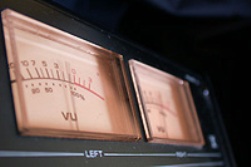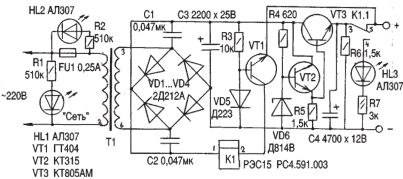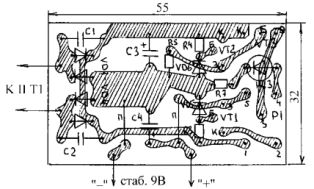Categories: Featured Articles » Practical Electronics
Number of views: 93855
Comments on the article: 0
Homemade power supply with short circuit protection
 Almost every beginner amateur radio seeks at the beginning of his work to design a network power supply, so that later it can be used to power various experimental devices. And of course, I would like this power supply to “tell” about the danger of failure of individual nodes in case of installation errors or malfunctions.
Almost every beginner amateur radio seeks at the beginning of his work to design a network power supply, so that later it can be used to power various experimental devices. And of course, I would like this power supply to “tell” about the danger of failure of individual nodes in case of installation errors or malfunctions.
To date, there are many schemes, including with an indication of a short circuit at the output. In most cases, such an indicator is usually an incandescent lamp included in the load gap. But with this inclusion, we increase the input resistance of the power source or, more simply, limit the current, which in most cases, of course, is acceptable, but not at all desirable.
The circuit shown in Fig. 1 not only signals a short circuit, absolutely without affecting the output impedance of the device, but also automatically disconnects the load when the output is shorted. In addition, the HL1 LED reminds that the device is plugged in, and HL2 lights up when the fuse FU1 blows, indicating the need to replace it.
Electrical circuit diagram of a self-made power supply with short circuit protection
Consider the work of a homemade power supply. The alternating voltage removed from the secondary winding T1 is rectified by the diodes VD1 ... VD4, assembled according to the bridge circuit. Capacitors C1 and C2 prevent the penetration of high-frequency noise into the network, and the oxide capacitor C3 smoothes the ripple of the voltage supplied to the input of the compensation stabilizer, assembled on VD6, VT2, VT3 and provides a stable voltage of 9 V.
The stabilization voltage can be changed by selecting the Zener diode VD6, for example, at KS156A it will be 5 V, at D814A - 6 V, at DV14B - V V, at DV14G -10 V, at DV14D -12 V. If desired, the output voltage can be made adjustable, for this, between the anode and cathode VD6 include a variable resistor with a resistance of 3-5 kOhm, and the base VT2 is connected to the engine of this resistor.
Consider the operation of a protective device power unit. The short circuit protection node in the load consists of a germanium pnp transistor VT1, an electromagnetic relay K1, a resistor R3 and a diode VD5. The latter in this case performs the function of a stabilizer supporting, on the basis of VT1, a constant voltage of about 0.6 - 0.7 V relative to the total.
In the normal mode of operation of the stabilizer, the transistor of the protection unit is reliably closed, since the voltage at its base relative to the emitter is negative. When a short circuit occurs, the emitter VT1, like the emitter of the regulating VT3, is connected to the common negative rectifier wire.
In other words, the voltage at its base relative to the emitter becomes positive, as a result of which VT1 opens, K1 trips and disconnects the load with its contacts, the HL3 LED lights up. After eliminating the short circuit, the bias voltage at the emitter junction VT1 again becomes negative and it closes, relay K1 de-energizes, connecting the load to the output of the stabilizer.
Details for the manufacture of a power supply. Any electromagnetic relay with the lowest possible switching voltage. In any case, one indispensable condition must be met: the secondary winding T1 must give out a voltage equal to the sum of the stabilization and relay operation voltages, i.e. if the stabilization voltage, as in this case, 9 V, and UIf the relay is 6 V, then the secondary winding must be at least 15 V, but also not exceed the permissible transistor on the collector-emitter. The author used TVK-110L2 as a T1 on a prototype.The circuit board of the device is shown in Fig. 2.
Power supply circuit board
Prus S.V.
See also at bgv.electricianexp.com
:


